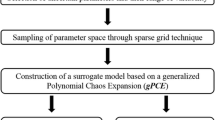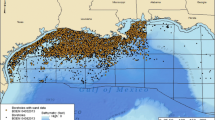Abstract
We present a model-driven uncertainty quantification methodology based on sparse grid sampling techniques in the context of a generalized polynomial chaos expansion (GPCE) approximation of a basin-scale geochemical evolution scenario. The approach is illustrated through a one-dimensional example involving the process of quartz cementation in sandstones and the resulting effects on the dynamics of the vertical distribution of porosity, pressure, and temperature. The proposed theoretical framework and computational tools allow performing an efficient and accurate global sensitivity analysis (GSA) of the system states (i.e., porosity, temperature, pressure, and fluxes) in the presence of uncertain key mechanical and geochemical model parameters as well as boundary conditions. GSA is grounded on the use of the variance-based Sobol indices. These allow discriminating the relative weights of uncertain quantities on the global model variance and can be computed through the GPCE of the model response. Evaluation of the GPCE of the model response is performed through the implementation of a sparse grid approximation technique in the space of the selected uncertain quantities. GPCE is then be employed as a surrogate model of the system states to quantify uncertainty propagation through the model in terms of the probability distribution (and its statistical moments) of target system states.
Similar content being viewed by others
References
Abercrombie, H.J., Hutcheon, I.E., Bloch, J.D., de Caritat, P.: Silica activity and the smectite–illite reaction. Geology 22, 539–542 (1994)
Archer, G.E.B., Saltelli, A., Sobol, I.M.: Sensitivity measures, ANOVA-like techniques and the use of bootstrap. J. Stat. Comput. Simul. 58(2), 99–120 (1997)
Babuška, I., Chatzipantelidis, P.: On solving elliptic stochastic partial differential equations. Comput. Methods Appl. Mech. Eng. 191(37–38), 4093–4122 (2002)
Bäck, J., Nobile, F., Tamellini, L., Tempone, R.: Stochastic spectral Galerkin and collocation methods for PDEs with random coefficients: a numerical comparison. In: Hesthaven, J., Ronquist, E. (eds.) Spectral and High Order Methods for Partial Differential Equations, Lecture Notes in Computational Science and Engineering, vol. 76, pp. 43–62. Springer, New York (2011)
Barthelmann, V., Novak, E., Ritter, K.: High dimensional polynomial interpolation on sparse grids. Adv. Comput. Math. 12(4), 273–288 (2000)
Beck, J., Nobile, F., Tamellini, L., Tempone, R.: On the optimal polynomial approximation of stochastic PDEs by Galerkin and collocation methods (2011). To appear on Mathematical Models & Methods in Applied Sciences. Also available as MOX-Report 23-2011
Bjorkum, P.A.: How important is pressure in causing dissolution of quartz in sandstones? J. Sediment. Res. 66, 147–154 (1996)
Bjorlykke, K.: Fluid-flow processes and diadenesis in sedimentary basins. Spec. Publ. Geol. Soc. Lond. 78, 127–140 (1994)
Bjorlykke, K., Hoeg, K.: Effects of burial diagenesis on stresses, compaction and fluid flow in sedimentary basins. Mar. Pet. Geol. 14, 267–276 (1997)
Brezzi, F., Fortin, M.: Mixed and Hybrid Finite Element Methods. Springer, New York (1991)
Buller, A.T., Bjorkum, P.A., Nadeau, P., Walderhaug, O.: Distribution of hydrocarbons in sedimentary basins. Statoil ASA, Res. Techn. Memoir 7, 1–15 (2005)
Bungartz, H., Griebel, M.: Sparse grids. Acta Numer. 13, 147–269 (2004)
Chen, Z., Ewing, R.E., Lu, H., Lyons, S.L., Maliassov, S., Ray, M.B., Sun, T.: Integrated two-dimensional modeling of fluid flow and compaction in a sedimentary basin. Comput. Geosci. 6, 545–564 (2002)
Constantine, P., Eldred, M., Phipps, E.: Sparse pseudospectral approximation method. ArXiv repository item number: arXiv:1109.2936v1 (2011)
Dempster, A.P.: Upper and lower probabilities induced by a multivalued mapping. Ann. Math. Stat. 38, 325–339 (1967)
Fajraoui, N., Ramasomanana, F., Younes, A., Mara, T., Ackerer, P., Guadagnini, A.: Use of global sensitivity analysis and polynomial chaos expansion for interpretation of non-reactive transport experiments in laboratory-scale porous media. Water Resour. Res. 47(2), W02521 (2011)
Gautschi, W.: Orthogonal Polynomials: Computation and Approximation. Oxford University Press, Oxford (2004)
Gerritsma, M., van der Steen, J.B., Vos, P., Karniadakis, G.: Time-dependent generalized polynomial chaos. J. Comput. Phys. 229(22), 8333–8363 (2010)
Gerstner, T., Griebel, M.: Dimension-adaptive tensor-product quadrature. Computing 71(1), 65–87 (2003)
Ghanem, R.G., Spanos, P.D.: Stochastic Finite Elements: A Spectral Approach. Springer, New York (1991)
Giles, M., Indrelid, S.L., Beynon, G.V., Amthor, J.: The origin of large-scale quartz cementation: evidence from large data sets and coupled heat-fluid mass transport modelling. Spec. Publ. Int. Assoc. Sedimentol. 29, 21–38 (2000)
Hadipriomo, F.: Fuzzy sets in probabilistic structural mechanics. In: Sundrarajan, C. (ed.) Probabilistic Structural Mechanic Handbook: Theory and Industrial Applications, pp. 280–316. Chapman and Hall, London (1995)
Kleiber, M., Hien, T.D.: The Stochastic Finite Element Method: Basic Perturbation Technique and Computer Implementation. Wiley, Chichester (1992)
Klir, G.J., Yuan, B.: Fuzzy Sets and Fuzzy Logic: Theory and Applications. Prentice Hall, Upper Saddle River (1995)
Land, L.S., Dutton, S.P.: Cementation of a Pennsylvanian deltaic sandstone; isotopic data. J. Sediment. Res. 48, 1167–1176 (1978)
Lander, R.H., Walderhaug, O.: Predicting porosity through simulating sandstone compaction and quartz cementation. AAPG Bull. 83(3), 433–449 (1999)
Le Maître, O.P., Knio, O.M.: Spectral methods for uncertainty quantification. In: Scientific Computation. Springer, New York (2010)
Mello, U.T., Rodrigues, J.R.P., Rossa, A.L.: A control-volume finite-element method for three-dimensional multiphase basin modeling. Mar. Pet. Geol. 26, 504–518 (2009)
Milliken, K.L.: Late diagenesis and mass transfer in sandstone-shale sequences. Treatis Geochem. 7, 115–158 (2004)
Mullis, A.M.: The role of silica precipitation kinetics in determining the rate of quartz pressure solution. J. Geophys. Res. 26, 69–112 (1991)
Nadeau, P.H.: Lessons learned from the golden zone concept for understanding overpressure development, and drilling safety in energy exploration. Working paper, Deepwater Horizon Study Group (2011)
Oelkers, E.H., Bjorkum, P.A., Murphy, W.M.: The mechanism of porosity reduction, stylolite development and quartz cementation in North Sea sandstones. In: Kharaka, Y.K., Maest, A.S. (eds.) Water Rock Interaction, pp. 1183–1186. Balkema, Rotterdam (1992)
Oelkers, E.H., Bjorkum, P.A., Murphy, W.M.: A petrographic and computational investigation of quartz cementation and porosity reduction in North Sea sandstones. Am. J. Sci. 296, 420–452 (1996)
Quarteroni, A., Sacco, R., Saleri, F.: Numerical mathematics. In: Texts in Applied Mathematics, vol. 37, 2nd edn. Springer, Berlin (2007)
Ramm, M.: Porosity-depth trends in reservoir sandstones: theoretical model related to Jurassic sandstones offshore Norway. Mar. Pet. Geol. 9, 553–567 (1992)
Sageman, B.B., Lyons, T.W.: Geochemistry of fine-grained sediments and sedimentary rocks. Treatise Geochem. 7, 115–158 (2004)
Saltelli, A., Ratto, M., Tarantola, S., Campolongo, F.: Sensitivity analysis practices: strategies for model based inference. Reliab. Eng. Syst. Saf. 91, 1109–1125 (2006)
Shafer, G.: A Mathematical Theory of Evidence. Princeton University Press, Princeton (1976)
Smolyak, S.: Quadrature and interpolation formulas for tensor products of certain classes of functions. Dokl. Akad. Nauk SSSR 4, 240–243 (1963)
Sobol’ I.M.: Global sensitivity indices for nonlinear mathematical models and their Monte Carlo estimates. Math. Comput. Simulat. 55(1–3), 271–280 (1991)
Stephenson, L.P., Plumley, W.J., Palciauskas, V.V.: A model for sandstone compaction by grain interpenetration. J. Sediment. Petrol. 62, 11–22 (1992)
Sudret, B.: Global sensitivity analysis using polynomial chaos expansions. Reliab. Eng. Syst. Saf. 93(7), 964–979 (2008)
Trefethen, L.N.: Is Gauss quadrature better than Clenshaw–Curtis? SIAM Rev. 50(1), 67–87 (2008)
Walderhaug, O.: Precipitation rates for quartz cement in sandstones determined by fluid-inclusion microthermometry and temperature-history modelling. J. Sediment. Res. A64, 324–333 (1994)
Walderhaug, O.: Kinetic modeling of quartz cementation and porosity loss in deeply buried sandstone reservoirs. AAPG Bull. 80, 731–745 (1996)
Walderhaug, O., Lander, R.H., Bjorkum, P.A., Oelkers, E.H., Bjolykke, K., Nadeau, P.H.: Modelling quartz cementation and porosity in reservoir sandstones: examples from Norwegian continental shelf. Spec. Publ. Int. Assoc. Sediment. 29, 39–49 (2000)
Wangen, M.: Physical Principles of Sedimentary Basin Analysis. Cambridge University Press, Cambridge (2010)
Weyl, P.K.: Pressure solution and the force of cristallization—a phenomenological theory. J. Geophys. Res. 64, 2001–2025 (1959)
Worden, R., Morad, S.: Quartz cementation in oil field sandstone: a review of the key controversies. Spec. Publ. Int. Assoc. Sediment. 29, 1–20 (2000)
Xiu, D., Karniadakis, G.: The Wiener–Askey polynomial chaos for stochastic differential equations. SIAM J. Sci. Comput. 24(2), 619–644 (2002)
Author information
Authors and Affiliations
Corresponding author
Rights and permissions
About this article
Cite this article
Formaggia, L., Guadagnini, A., Imperiali, I. et al. Global sensitivity analysis through polynomial chaos expansion of a basin-scale geochemical compaction model. Comput Geosci 17, 25–42 (2013). https://doi.org/10.1007/s10596-012-9311-5
Received:
Accepted:
Published:
Issue Date:
DOI: https://doi.org/10.1007/s10596-012-9311-5




